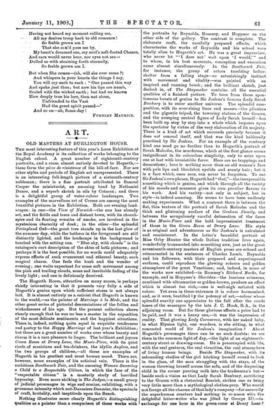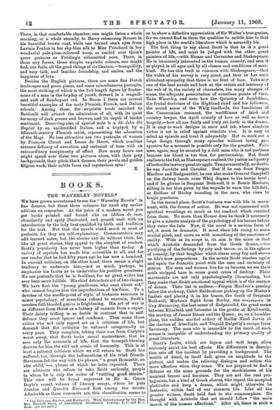ART.
OLD MASTERS AT BURLINGTON HOUSE.
THE most interesting feature of this year's Loan Exhibition at the Royal Academy is its collection of works belonging to the English reboot A great number of eighteenth-century portraits, and a room almost entirely devoted to Hogarth,- these form the piece de risistance of the bill-of-fare. Nor are other styles and periods of English art unrepresented. There is an interesting full-length picture of a sixteenth-century nobleman ; there is a fine . portrait attributed to Samuel Cooper the miniaturist, an amusing head by Nathaniel Dance, and a superb sketch in oils by Cotman ; and there is a delightful group of water-colour landscapes. Two examples of the marvellous art of Crome are among the most beautiful pictures in the Exhibition. Both are evening land- scapes: in one—the View of Norwich—the sun has already set, and the fields and trees and distant town, with its church- spire and its floating wreaths of smoke, are involved in the mysterious obscurity of dusk ; in the other—the splendid Poringland Oak—the great tree stands up in the last glow of the summer day, while the bathers in the foreground are still distinctly lighted, and the landscape in the background is touched with the setting sun. "Blue sky, with clouds" is the catalogue's curt description of the skies of both pictures; and perhaps it is the best possible, for no words could adequately express effects of such evanescent and ethereal beauty, such magical charm. One feels the hush and the wonder of evening ; one waits expectant for some soft movement among the pink and trailing clouds, some sad inevitable fading of the lovely light ; and one is deliciously deceived.
The Hogarth Room, attractive on many scores, is perhaps chiefly interesting in that it presents very fully a aide of Hogarth's genius upon which sufficient stress is not always laid. It is almost entirely as a satirist that Hogarth is known to the world,—as the painter of Marriage a la Mode, and the other great series of pictorial denunciations of the follies and wickednesses of his age. But the present collection shows clearly enough that he was no less a master in the exposition of the most delicate sentiments and the happiest situations. There is, indeed, nothing quite equal in exquisite tenderness and poetry to the Happy Marriage of last year's Exhibition ; but there are a great number of works over whose beauty and charm it is a rare pleasure to linger. The brilliant and joyous Green Room at Drury Lane, the Music-Piece, with its quiet circle of musicians and tea-drinkers, the idyllic Anglers, and the two groups of children,—all these are examples of Hogarth in his gentlest and most human mood. There are, however, some examples of his satirical vein. There is the ambitious Southwark Fair, and the amusing Woman Swearing a Child to a Respectable Citizen, in. which the face of the "respectable citizen" is a masterly study of horrified hypocrisy. Even more striking is The ..Tuclges,—a small group of judicial personages in wigs and ermine, exhibiting, with a gruesome intensity which out-Daumiers Daumier, the spectacle of craft, brutality,-and ineptitude. upon the Bench.
Nothing illustrates more •clearly Hogarth's distinguishing qualitiee as a painter • than a comparison Of these worke with
the portraits by Reynolds, Romney, and Hoppuer on the other side of the gallery. The contrast is complete. The elaborate craft, the carefully prepared effects, which characterise the works of Reynolds and his school were totally alien to Hogarth's art. He was a. great improviser, who never let "'I dare not' wait upon 'I would.'" and to whom, in his best moments, conception and execution came almost simultaneously. In the Southwark Fair, for -instance, - the grouP of actors tumbling helter- skelter from a falling stage—so astonishingly instinct with movement and vitality—was painted with an inspired and running brush ; and the brilliant sketch, just dashed in, of The Staymaker contains all the essential qualities of a finished picture. To turn from these Spoil.: taneous bursts of genius to Sir Joshua's famous Lady Scirak Bunbury is to enter another universe. The splendid com- position, with its ever-rising lines and masses—the pilasters and the gigantic tripod, the towering statues of the Graces, and the sweeping central figure of Lady Sarah herself—has been built up step by step into a whole which imposes upon the spectator by virtue of the very elaboration of its majesty. There is a kind of art which succeeds precisely because it does not conceal itself, and that was the kind habitually practised by Sir Joshua. For an example of the contrary kind one need go no further than to Hogarth's portrait of Sarah Malcolm, the murderess, which at the first glance seems insignificant in its colourless simplicity, only to seize upon one at last with irresistible force. Here are no trappings and decorations ; here is nothing more than an old woman's face with pale lips and bloodshot eyelids and scanty hair ; but it is a face which, Once seen, can never be for-gotten. To use Sir Joshua's own phrase, Hogarth had "that,"—the inexpressible something which is genius, and which through all the variety of his moods and manners gives its own peculiar flavour to his work. And his variety—not only in subject, but in style—is indeed amazing. He seems to have been endlessly making experiments. What a contrast there is between the flat, thin texture of the portrait of Sarah Malcolm and the thick and glistening surface of the Graham Family, and between the scrupulously careful delineation Of the faces in the Music-Piece and the bold impressionist treatment of those in -the Green Room at Drury Lane. His style is as original and adventurous as Sir Joshua's is calculated and reminiscent. In the latter's beautiful portrait of Miss Orby Mutter the whole Italian tradition lives again, wonderfully transmuted into something new, just as the great seventeenth-century masters of English prose are echoed and reincarnated in the sentences of Charles Lamb. Reynolds. and his followers, with their prepared and superimposed surfaces, could reproduce the glowing colours and golden atmosphere of the great Venetians ; and, indeed, in some of the works now exhibited—in Romney's Richard Burke, for example, and in Hoppner's Sheridan—the luscious crimsons," combined with ultramarine or golden-brown, produce an effect which is almost too rich,—one is well-nigh satiated with colour. Yet even in these extremes it is colour harmonised, and, as it were, beatified ly the potency of ark—colour whose splendid suavity one appreciates to the full after the crude tones of the seascapes by the late J. C. Hook, R,A., in the adjoining room. But for these glorious effects a price had to be paid, and it was a heavy one,—it was the impression of reality. That glowing Lady Cameroon, with her naked baby, in what Elysian light, one wonders, is she sitting, in what concocted world of Sir Joshua's imagination ? About Hogarth's personages there can be no such doubts: we see them in the common light of day,—the light of an eighteenth- century street or drawing-room. He is preoccupied with life, with the real gestures, the real vivacities, the real atmosphere of living human beings. Beside The Staymaker, with its astounding studies of the girl hitching herself round to look in the glass, of the man struggling with the stays, of the woman throwing herself across the sofa, and of the disgusting child in the corner pouring milk into the tradesman's hat—. beside such a vision as that Lady Sarah Bunbury, sacrificing to the Graces with a rhetorical flourish, strikes one as being very little more than a mythological clothes-prop. Who would not forego all the charms of that lady's company—for assuredly the superhuman creature had nothing in common with the delightful letter-writer who was jilted by George IIL—in exchange.-for one hour in the green-room at -Drury Lane ?
There, in that comfortable chamber, one might listen a whole morning, or a whole eternity, to Barry rehearsing Romeo in his beautiful brown coat, while one turned one's eyes from Lavinia Fenton in her sky-blue silk to Miss Pritchard in her wonderful pale-plum-coloured hoop, or smiled over Quin's queer gestures or Fielding's silhouetted nose. There, in those airy forms, those simple, exquisite colours, one might find, one feels, all the good things of civilisation,—tranquillity, and easy talk, and familiar friendship, and smiles, and the happiness of love.
Besides the English pictures, there are some fine Dutch landscapes and genre pieces, and some miscellaneous portraits, the most striking of which is the full-length figure by Suster- mans of a man in the heyday of youth, dressed in a magnifi- cent suit of flamboyant red. In Room I. there are several beautiful examples of the early Flemish, French, and Italian schools. Among these, the exquisite tondo ascribed to Botticelli will attract the admiration of all, with its quiet harmony of dark greens and browns, and its depth of tender sentiment. Deserving also of special note is a St. John the Baptist by an unidentified Italian, and a triptych by a fifteenth-century Flemish artist, representing the adoration of the Magi. No less attractive are two portraits of women by Francois Clouet and Lucas de Heere, which combine extreme delicacy of execution and restraint of tone with an extraordinary sumptuosity of effect. How many hours one might spend over these two pictures alone, with their grey backgrounds, their pitch-black dresses, their jewels and golden filigree-work, their subtle faces and mysterious eyes !
Z.











































 Previous page
Previous page